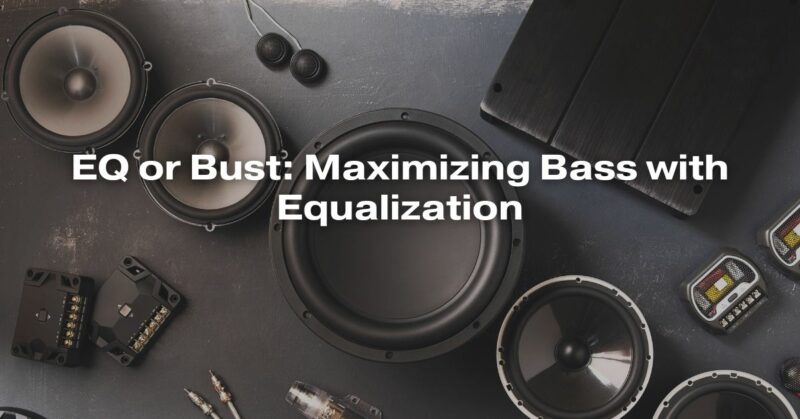Music is a universal language that transcends borders and cultures. It has the power to stir emotions, evoke memories, and make us groove to the beat. One of the fundamental elements that can greatly enhance our musical experience is bass. Deep, resonant bass can add depth and richness to any musical composition, making it more immersive and enjoyable. However, achieving the perfect bass balance can be a challenging task, and this is where equalization (EQ) comes into play.
Equalization is a fundamental tool in audio engineering and music production that allows us to control and shape the frequency response of audio signals. When it comes to maximizing bass, EQ can be a game-changer, helping to sculpt the low-end frequencies to perfection. In this comprehensive article, we will delve into the world of equalization and explore how it can be used to maximize bass in various contexts.
Understanding the Basics of Equalization
Before we dive into the specifics of maximizing bass with EQ, it’s essential to understand the fundamentals of equalization. Equalization involves adjusting the amplitude of specific frequency bands within an audio signal to shape its tonal balance. The frequency range is typically divided into different bands, including low, mid, and high frequencies, each of which can be independently adjusted using EQ.
- Frequency Bands: When dealing with bass, we primarily focus on the low-frequency range, typically spanning from around 20 Hz to 250 Hz. This is where the thumping, rumbling, and resonating bass frequencies reside.
- Types of Equalizers: There are various types of EQs, including graphic EQs, parametric EQs, and shelving EQs. Each type offers different levels of control and precision.
- EQ Controls: EQ units typically provide controls for adjusting gain (amplitude), frequency (the specific frequency you want to affect), and bandwidth (the width of the frequency range you want to modify).
Maximizing Bass with EQ
- Identifying Problem Frequencies: The first step in maximizing bass with EQ is to identify problem frequencies. Sometimes, bass can be muddied or boomy due to room acoustics or recording issues. Use a spectrum analyzer or your ears to pinpoint these problematic frequencies.
- Cutting Unwanted Frequencies: To clean up the bass, start by making cuts in frequencies that are causing issues. For example, if there’s a muddiness around 100 Hz, use a parametric EQ to make a narrow cut in that frequency range. This will help remove unwanted resonances.
- Boosting the Sweet Spot: To enhance the overall bass presence, find the “sweet spot” where the bass sounds full and powerful without being overwhelming. This may vary depending on the musical genre and personal preferences. A gentle boost in the 60-80 Hz range can often add warmth and punch to the bass.
- Subtractive vs. Additive EQ: When working with bass, it’s often more effective to start with subtractive EQ, cutting unwanted frequencies, before applying any boosts. Subtractive EQ helps create a cleaner foundation to build upon.
- Use Low-Pass Filters: In some cases, it’s beneficial to use low-pass filters to remove very high-frequency content from the bass. This can reduce muddiness and make the bass more defined.
- Parallel Processing: Consider using parallel processing techniques, such as parallel compression or parallel saturation, to add richness and character to the bass without compromising clarity.
Context Matters: Live Sound vs. Studio Mixing
The application of EQ for maximizing bass can vary depending on the context. In live sound reinforcement, where you’re dealing with a physical space and often unpredictable room acoustics, EQ adjustments may be more focused on addressing room resonances and ensuring that the bass is evenly distributed throughout the venue.
In contrast, studio mixing offers more control over the recording and mixing process. Here, engineers have the luxury of fine-tuning the bass to achieve the desired sonic characteristics, whether it’s a thunderous low end for a hip-hop track or a tight, controlled bass for a jazz recording.
Conclusion
Maximizing bass with equalization is an art as much as it is a science. Understanding the fundamentals of equalization and having a discerning ear are essential for achieving the perfect bass balance in any musical context. Whether you’re a live sound engineer, a music producer, or an audiophile, mastering the art of EQ for bass can significantly enhance your musical experience. So, EQ or bust? When it comes to bass, EQ is undoubtedly the key to unlocking its full potential.


